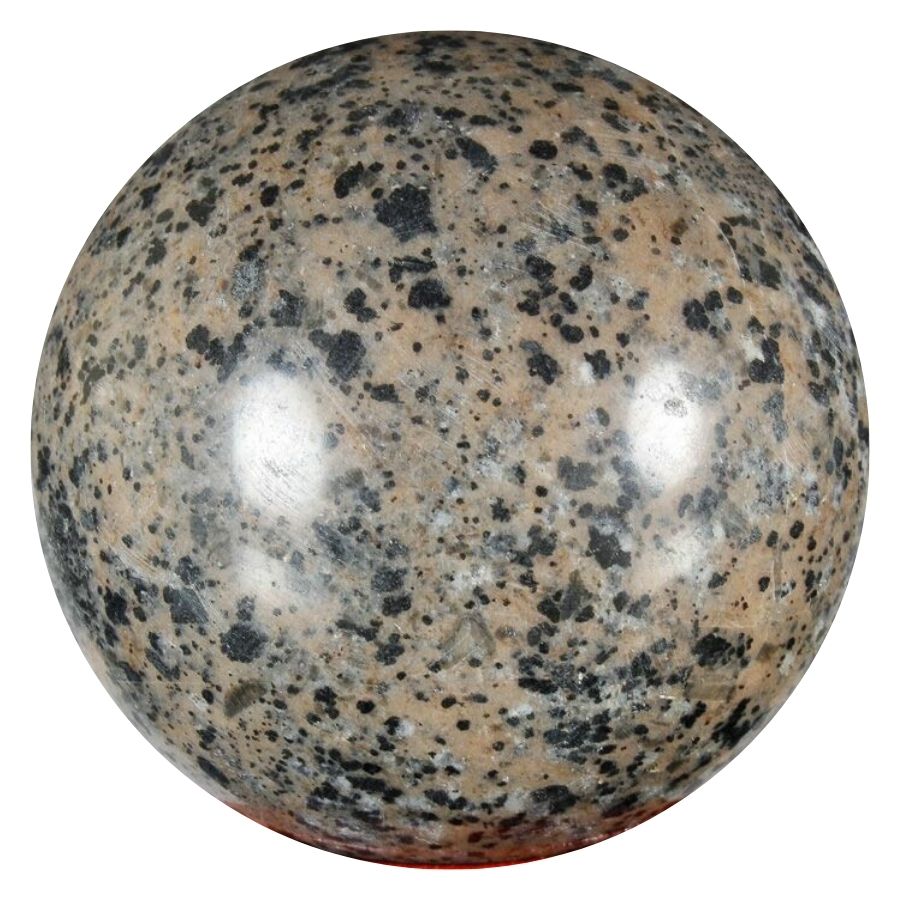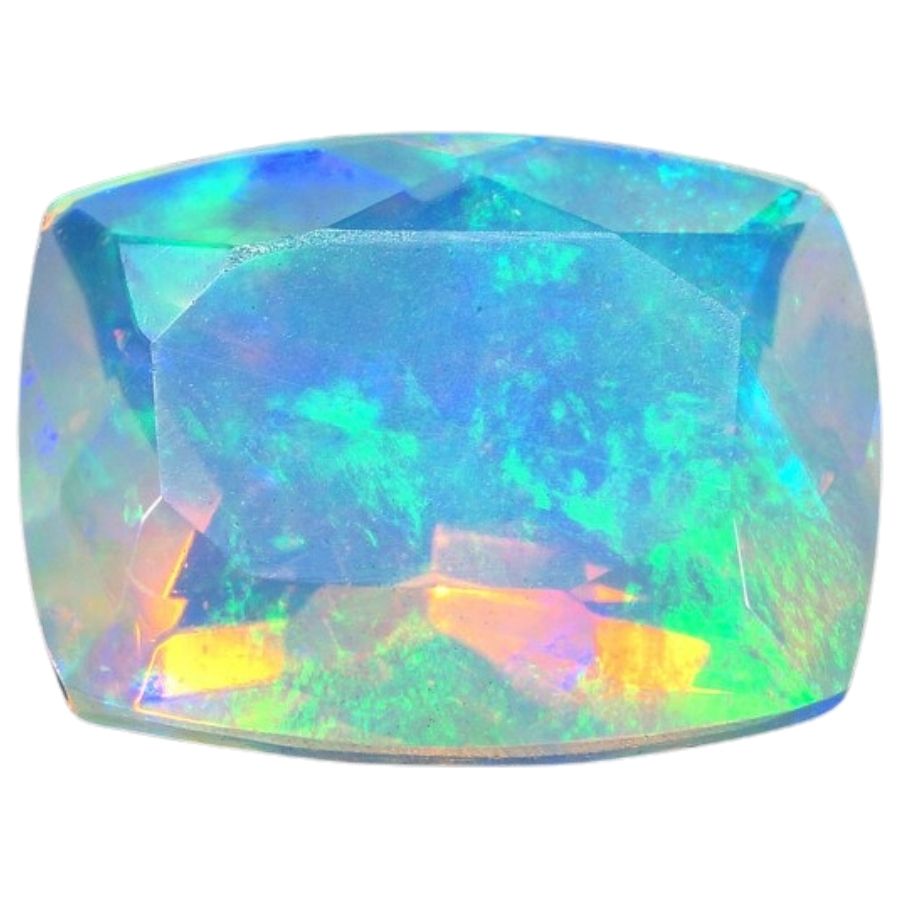Gemstones are not just pretty; they’re also fascinating because new ones are being found all the time. For example, recently discovered gems include aquadité, Welo opal, and new types of rubies and sapphires.
Finding new gemstones is like uncovering hidden treasures from the earth. Each new discovery adds to our understanding of the beautiful and diverse world of gemstones.
Recent Significant Gemstone Discoveries
In the past 100 years, there have been some exciting finds in the world of gemstones. These discoveries include both completely new gemstones and new variations of ones we already know.
Aquadité

Aquadité was first found in April 2022 on the Maluka Islands in Indonesia. It was discovered by accident when miners hit a rock while clearing a road.
This gemstone is a type of chalcedony, which is a form of quartz, and it has high amounts of copper in it. The copper is what gives aquadité its distinct color.
Aquadité has a striking blue-green color, similar to the hues of tropical ocean waters. When light hits it just right, the stone appears to glow from within, which is really neat to see.
Yooperlite

Yooperlite was first found in 2017 near Lake Superior in Michigan. Erik Rintamaki, who first discovered them, named them after the nickname for people from the Upper Peninsula of Michigan, called “Yoopers.”
Yooperlite is a type of syenite rock that contains fluorescent sodalite. This composition is what makes the stone glow under ultraviolet light.
In daylight, yooperlite looks like a regular gray rock. But under UV light, it glows with bright orange or yellow colors.
Peacock Aquaprase

Peacock aquaprase was first discovered in 2013 in Africa. The exact location of the discovery is not widely publicized, but it quickly gained attention in the gemstone world.
This gemstone is a type of chalcedony, which is a form of quartz. It contains trace amounts of chromium and nickel, which contribute to its coloring.
Peacock aquaprase is known for its turquoise blue color with streaks of green. It often has natural inclusions that create a cloudy or mossy appearance, adding to its beauty.
Welo Opal

Welo opal was first discovered in 2008 in the Welo region of Ethiopia. This discovery quickly made a big impact in the world of gemstones.
Welo opal is a type of precious opal, which means it’s made up of hydrated silica. Its water content can range from 3 to 21 percent.
What makes Welo opal stand out is its bright play-of-color, showing various hues like red, green, blue, and yellow. The colors seem to dance and change as you move the stone in light, making each opal unique in its display.
Pezzottaite

Pezzottaite was first discovered in 2002 in Madagascar. This gemstone was initially mistaken for another mineral but was later identified as a new variety.
Chemically, pezzottaite is a beryllosilicate mineral, which means it’s related to beryl, the mineral family that includes emeralds and aquamarines. It has a high lithium content, which differentiates it from other beryl varieties.
Pezzottaite is known for its raspberry to pink color. It doesn’t change color or fluoresce, but its rich hue makes it attractive.
Paraiba Tourmaline

Paraiba tourmaline was first discovered in the 1980s in the state of Paraíba, Brazil. This discovery was exciting because it brought a new kind of tourmaline to the world.
The special thing about Paraiba tourmaline is that it contains copper, which gives it bright blue, green, and violet colors. These colors are really bright and different from other tourmalines.
Paraiba tourmaline is known for its neon blue to green colors. These colors are so bright and vivid, they almost seem to glow.
Charoite

Charoite was first discovered in the 1940s near the Chara River in Russia. This was the only place in the world where this stone was found.
Chemically, charoite is a complex silicate mineral, which includes elements like calcium, silicon, and potassium. This composition gives it a distinct look and feel.
Charoite is known for its striking purple color, with swirling patterns of white, black, and lilac. These swirling patterns make each piece of charoite look like a unique painting.
Sugilite

Sugilite was first discovered in 1944 by a Japanese geologist named Ken-ichi Sugi, in Iwagi Islet, Japan. Later, in 1975, more deposits were found in South Africa, which is now the main source of sugilite.
Sugilite is a complex mineral made of potassium, sodium, lithium, iron, manganese, and aluminum. The presence of manganese gives sugilite its most common color, which is purple.
Sugilite is usually a deep purple color, but it can also be found in pinkish or reddish shades. It’s often opaque, but can sometimes be translucent, and it has a waxy, glassy shine.
Larimar

Larimar was first discovered in 1974 in the Dominican Republic. It’s found only in this Caribbean country, which makes it quite rare.
Chemically, larimar is a type of pectolite, which is made up of sodium and calcium silicate with hydrogen. What’s interesting is that it’s the only type of pectolite that has this captivating sea-blue color.
Larimar is known for its beautiful blue color, which can range from light blue to green-blue. It often has white streaks or patterns, which make it look like the ocean.
Colorless Sapphire
Gaspeite

Gaspeite was first discovered in the 1960s in the Gaspe Peninsula of Quebec, Canada. It’s named after this place where it was found.
Gaspeite is a nickel carbonate mineral, which also contains small amounts of magnesium and iron. These elements give gaspeite its distinctive color.
The color of gaspeite is usually a bright green, sometimes with brown or yellowish spots. This green color can range from pale to a rich, apple green.
Poudretteite

Poudretteite was first discovered in the 1960s at the Poudrette Quarry in Mont Saint-Hilaire, Quebec, Canada. It’s named after the family that operated the quarry.
This gemstone is a borosilicate mineral, which means it’s made of boron, silicon, and oxygen. Poudretteite also has potassium and hydrogen in its structure.
Poudretteite is known for its light pink color, but it can also be colorless. It’s a very rare gemstone, and it’s usually found in small sizes.
Tanzanite

Tanzanite was first discovered in 1967 near Mount Kilimanjaro in Tanzania. It is found only in this part of the world, making it quite rare.
This gemstone is a variety of the mineral zoisite and contains calcium, aluminum, silicon, and oxygen. The presence of vanadium gives tanzanite its distinctive blue-violet color.
Tanzanite is known for its striking blue to violet colors. It can also show different colors when viewed from different angles, a feature known as pleochroism.
Tsavorite Garnet

Tsavorite garnet was first discovered in 1967 in Tanzania, near Tsavo National Park. This park gave tsavorite its name.
Tsavorite is a type of garnet made of calcium, aluminum, silicon, and oxygen. It is part of the grossular garnet family.
The color of tsavorite garnet ranges from bright green to deep forest green. This gemstone does not change color and does not fluoresce, but its vivid green is highly prized.
Musgravite

Musgravite was first discovered in 1967 in the Musgrave Ranges of South Australia. This rare gemstone is named after the location where it was found.
Musgravite is a type of taaffeite, which is made up of beryllium, magnesium, and aluminum. The chemical formula for musgravite makes it one of the rarer gems in the world.
The color of musgravite ranges from a light greenish gray to a deep violet. It’s known for its extreme rarity and does not typically show color change or fluorescence.


